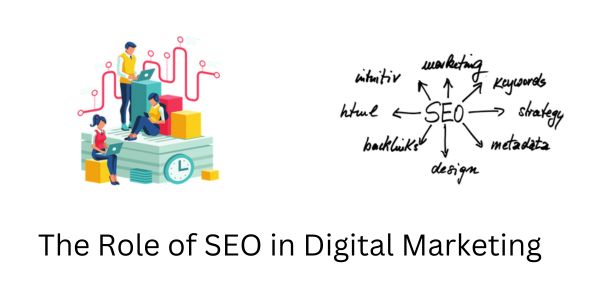In digital marketing, the function of SEO (search engine optimization). This is necessary for companies for an online presence in SERPs. And to expand their digital presence from the role of SEO in digital marketing. Achieve higher rankings on SERPs for relevant keywords and phrases. And expertise in many facets of digital marketing.

What are the best SEO practices and strategies?
The following is a list of best practices and strategies for the effective usage of SEO.
Research on Keywords
Keyword research is the process of finding keywords. And enables to optimize the content of their websites. Use Google Keyword Planner and SEMrush. Or MOZ Keyword Explorer for doing productive keyword research. These SEO tools allow users to locate keywords with high search volume. And low levels of competition for the products or services.
On-Page Optimization
The goal of on-page SEO is to improve a website’s visibility. And relevance in search engine results by focusing on optimizing single web pages. This includes optimizing the meta tags to include the target keywords. Using the exact heading tags (H₁, H₂, etc.) to structure the content. Optimizing the URL structures and keywords naturally and strategically.
The production of content of high quality. That is relevant at the heart of an efficient SEO strategy. Search engines give websites that offer users content. That is both useful and interesting higher priority. The creation of informative content, such as blog posts, articles, and guides. Multimedia content helps in attracting organic traffic and improves user engagement. And confirms the company as an authority in which it operates. Need to produce content that satisfies the objectives of users. And respond to the questions they have. And offers the best satisfying experience.
SEO Technical
SEO focuses on improving a website’s visibility. And accessibility to search engines by optimizing the technical aspects of a website. This includes optimizing a website’s speed by reducing the loading time. It takes for a page to load, design is mobile-friendly responsive pages. Fixing broken links and redirecting error pages. And optimizing XML sitemaps for crawling and indexing of web pages. And implementing structured data markup to improve a search engine’s view of content. Backlinks act as votes of confidence.
So that, search engines can trust the reliability of the website. And valuable by pointing to it from other websites. Building a robust backlink profile for a website by employing tactics. Such as guest blogging, influencer, outreach, and content promotion. And the creation of content that is shareable helps to increase the website authority. As well as ranking in search engine results pages of search engines.
Optimization of the User-Experience (UX)
SEO places a significant emphasis on user-experience. When you optimize for user-experience. You need to make sure that page’s load quickly. And that you optimize for mobile devices. And use navigation that is easy to use and enhance your site architecture. That you improve ease of reading and convenience. And that you use design elements that are interactive and pleasing.
Local search engine optimization
This is mandatory for any company that intends to serve local clients. It enhances the website’s online presence to cater to local search queries. This includes creating and optimizing a local listing on Google My Business. And get online reviews and ratings. Ensuring that the NAP (Name, address, and phone number). Information across online directories is consistent and accurate. And targeting location-specific keywords. Local search engine optimization helps businesses appear in local search results. And attracts customers from the surrounding area.
Monitoring, Analytical Work, and Ongoing Optimization
SEO is an ongoing process that needs to be monitored and analyzed. And optimize it for the basis of an ongoing process. Tracking website performance, monitoring keyword rankings, and measuring organic traffic. And use tools such as Google Analytics and Google Search Console. So, that you can make decisions that are driven by data. And optimize SEO efforts to adapt to changing algorithms for user behavior, and industry trends. It is helpful to analyze data and key metrics.
What are the key aspects of SEO?
Here are the key aspects of SEO and its role in digital marketing:
Organic Search Visibility
Search engines, such as Google, Bing, and Yahoo. These are most businesses’ primary website traffic sources. SEO helps websites appear prominently in organic search results. Improving their visibility to potential customers. By optimizing relevant keywords and providing high-quality content. Businesses can increase their chances of appearing in top search results. Leading to greater exposure and click-through rates.
Increased Website Traffic
SEO is a powerful tool for driving organic traffic to a website. And attract clicks from users searching for relevant information and products. Or services by optimizing on-page elements (e.g., meta tags, headings, content). And off-page factors (e.g., backlinks, social signals). Businesses can improve their website’s clarity and drive targeted traffic. Increasing the conveniences for conversions and revenue generation.
Targeted Audience Reach
SEO enables businesses to reach a highly targeted audience. By optimizing for specific keywords related to their industry, products, or services. Businesses can attract users who are actively searching for what they offer. This targeted approach to attracting qualified leads improves conversion rates. And maximizing the return on investment (ROI) of digital marketing efforts.
Conclusion
To summarize, SEO is an essential component of digital marketing. Because it raises a website’s visibility and increase organic traffic. And strengthens an organization’s online presence. The usage of best practices and strategies. Such as keyword research, on-page SEO, and quality content creation. And also, for the technical SEO, and link building. And also, User-experience (UX) optimization, local SEO, and continuous monitoring. That can have a significant impact on the search engine rankings. And the online success of a business.